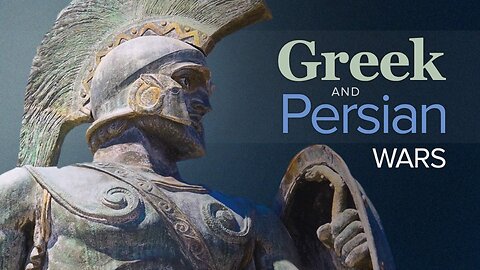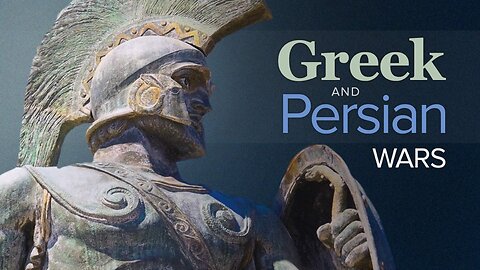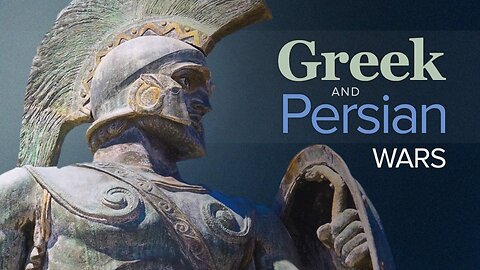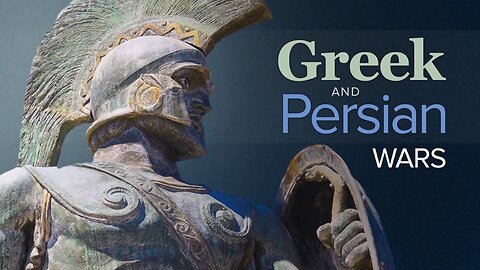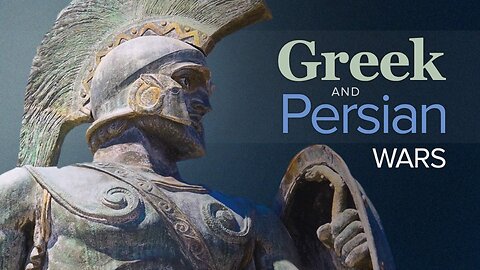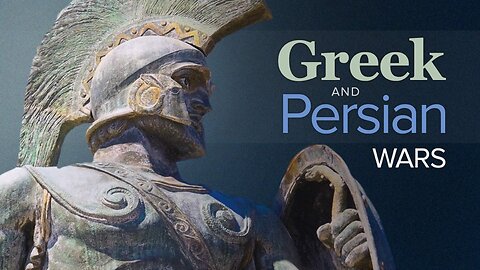
Greek and Persian Wars
24 videos
Updated 4 months ago
24 lectures, 30 minutes/lecture
Taught by John R. Hale
Ph.D. Professor, University of Louisville
-
Greek and Persian Wars | The First Encounter (Lecture 1)
 Adaneth - History&Politics24 lectures, 30 minutes/lecture Taught by John R. Hale Ph.D. Professor, University of Louisville This course presents a rare opportunity to survey the entirety of the two centuries-long conflict between the Greeks and the Persians: the greatest military contest in antiquity and one that forever changed the patterns of human history. Ruled by such Great Kings as Cyrus II (known as Cyrus the Great), Darius III, and Xerxes, the Persian Empire’s extraordinary military might, bottomless treasury, and innovative engineering skills made it seem almost inconceivable that any nation could long resist conquest. Resilient opposition, however, came from the Greek - first from the Ionian cities of Asia Minor, then from the leagues of city-states led by Sparta and Athens, and finally, from the kingdom of Macedon under its fabled rulers King Philip II and his son Alexander III (better known as Alexander the Great). Beginning with the first Persian capture of Greek cities in the mid-6th century B.C. and concluding with the burning of the Persian royal city of Persepolis in 331 B.C., this tumultuous period was punctuated with some of history’s most dramatic battles: the violent clash of soldiers on the plains at Marathon, the defiant last stand of 300 Spartans at Thermopylae, the crucial naval battle in the straits of Salamis, the march of the Ten Thousand under Xenophon, and the astonishing victories of Alexander at Granicus River, Issos, and Gaugamela that finally brought the wars to an end. Ultimately, this period set the stage not only for the immediate future of the Classical age but for the perpetual collision between East and West; many subsequent clashes—between Rome and Parthia, Christian Crusaders and Muslim Saracens, Byzantines and Ottomans—have been fought along this same fundamental fault line. A comprehensive study of the Greek and Persian wars, one that takes into account a view of the hostilities from both sides and augments the historical narrative with explorations of emergent cultural and political traditions, remains crucial to understanding the complex issues that still beset our modern world. Lecture 1: The two centuries of hostilities that encompass the Greek and Persian wars saw numerous political, social, economic, and cultural developments. More importantly, however, this archetypal war between East and West prefigured all later conflicts along the cultural fault line running through the eastern Mediterranean. The first encounter between these two disparate civilizations occurred around 546 B.C., with King Croesus of Lydia’s preemptive attack against the emerging Persian Empire and its ruler, King Cyrus II (known as Cyrus the Great). With the aid of Greek hoplite mercenaries from the Peloponnese, Croesus crossed the Halys River and fought the Persians to a standstill, until a lightning-like attack turned the battle in favor of the Persian Empire. The Lydians’ subsequent defeat cemented Cyrus’s role as the new lord of Asia Minor and alerted mainland Greece to the Persian menace. Thus was a spark ignited that would, in the time of Cyrus’s successors, be fanned into a conflagration. Recommended Reading: Allen, The Persian Empire. Herodotus, The Histories.351 views
Adaneth - History&Politics24 lectures, 30 minutes/lecture Taught by John R. Hale Ph.D. Professor, University of Louisville This course presents a rare opportunity to survey the entirety of the two centuries-long conflict between the Greeks and the Persians: the greatest military contest in antiquity and one that forever changed the patterns of human history. Ruled by such Great Kings as Cyrus II (known as Cyrus the Great), Darius III, and Xerxes, the Persian Empire’s extraordinary military might, bottomless treasury, and innovative engineering skills made it seem almost inconceivable that any nation could long resist conquest. Resilient opposition, however, came from the Greek - first from the Ionian cities of Asia Minor, then from the leagues of city-states led by Sparta and Athens, and finally, from the kingdom of Macedon under its fabled rulers King Philip II and his son Alexander III (better known as Alexander the Great). Beginning with the first Persian capture of Greek cities in the mid-6th century B.C. and concluding with the burning of the Persian royal city of Persepolis in 331 B.C., this tumultuous period was punctuated with some of history’s most dramatic battles: the violent clash of soldiers on the plains at Marathon, the defiant last stand of 300 Spartans at Thermopylae, the crucial naval battle in the straits of Salamis, the march of the Ten Thousand under Xenophon, and the astonishing victories of Alexander at Granicus River, Issos, and Gaugamela that finally brought the wars to an end. Ultimately, this period set the stage not only for the immediate future of the Classical age but for the perpetual collision between East and West; many subsequent clashes—between Rome and Parthia, Christian Crusaders and Muslim Saracens, Byzantines and Ottomans—have been fought along this same fundamental fault line. A comprehensive study of the Greek and Persian wars, one that takes into account a view of the hostilities from both sides and augments the historical narrative with explorations of emergent cultural and political traditions, remains crucial to understanding the complex issues that still beset our modern world. Lecture 1: The two centuries of hostilities that encompass the Greek and Persian wars saw numerous political, social, economic, and cultural developments. More importantly, however, this archetypal war between East and West prefigured all later conflicts along the cultural fault line running through the eastern Mediterranean. The first encounter between these two disparate civilizations occurred around 546 B.C., with King Croesus of Lydia’s preemptive attack against the emerging Persian Empire and its ruler, King Cyrus II (known as Cyrus the Great). With the aid of Greek hoplite mercenaries from the Peloponnese, Croesus crossed the Halys River and fought the Persians to a standstill, until a lightning-like attack turned the battle in favor of the Persian Empire. The Lydians’ subsequent defeat cemented Cyrus’s role as the new lord of Asia Minor and alerted mainland Greece to the Persian menace. Thus was a spark ignited that would, in the time of Cyrus’s successors, be fanned into a conflagration. Recommended Reading: Allen, The Persian Empire. Herodotus, The Histories.351 views -
Greek and Persian Wars | Empire Builders: The Persians (Lecture 2)
 Adaneth - History&PoliticsLecture 2: Modern scholars have learned about the Persians in their own language thanks largely to the translation of the inscription at Behistun rock by Henry Rawlinson in the 1830s. That inscription tells the story of the accession of King Darius to the throne of the Persian Empire. Other Old Persian texts give us a sense of what the Persians were like both before and after they became the dominant power in the ancient world. It was Cyrus who initiated the drive to dominance, uniting the formerly tribal Persian people and leading them to expansion through the conquest of Media, Lydia, and other Greek city-states. Cyrus’s son Cambyses organized the ever-widening empire into provinces and continued the tradition of engineering projects begun by his father. One such project, the Royal Road, typifies the qualities of relentlessness, duty, and achievement that made the Persian Empire a force to be reckoned with. Recommended Reading: Kuhrt, The Persian Empire: A Corpus of Sources from the Achaemenid Period. Lyle, The Search for the Royal Road.234 views
Adaneth - History&PoliticsLecture 2: Modern scholars have learned about the Persians in their own language thanks largely to the translation of the inscription at Behistun rock by Henry Rawlinson in the 1830s. That inscription tells the story of the accession of King Darius to the throne of the Persian Empire. Other Old Persian texts give us a sense of what the Persians were like both before and after they became the dominant power in the ancient world. It was Cyrus who initiated the drive to dominance, uniting the formerly tribal Persian people and leading them to expansion through the conquest of Media, Lydia, and other Greek city-states. Cyrus’s son Cambyses organized the ever-widening empire into provinces and continued the tradition of engineering projects begun by his father. One such project, the Royal Road, typifies the qualities of relentlessness, duty, and achievement that made the Persian Empire a force to be reckoned with. Recommended Reading: Kuhrt, The Persian Empire: A Corpus of Sources from the Achaemenid Period. Lyle, The Search for the Royal Road.234 views -
Greek and Persian Wars | Intrepid Voyagers: The Greeks (Lecture 3)
 Adaneth - History&PoliticsLecture 3: Though the Greeks did not leave exact historical records about the Bronze Age period in which their culture and civilization developed, the myths and epics they left behind offer key insights into their origin and their establishment of great cities along the coast of Asia. By the end of the Bronze Age, Mycenaean Greeks were using their knowledge of shipbuilding and navigation to launch expeditions into Asia. As more Greeks headed east, they used Athens as a starting point for the foundation of such cities as Ephesus and Miletus; Rhodes and Halicarnassus were colonized by Dorian Greeks related to the Spartans. In time, these colonies far outshone their mother country in terms of population and cultural advancement. These Ionian Greeks were heavily influenced by the older cultures of Asia and Egypt, but they added their own distinctive skeptical rationalism to the mix. It was this unique world that Cyrus encountered as a result of his conquest of Lydia. Recommended Reading: Camp and Fisher, The World of the Ancient Greeks. Hanson, The Western Way of War: Infantry Battle in Classical Greece.183 views
Adaneth - History&PoliticsLecture 3: Though the Greeks did not leave exact historical records about the Bronze Age period in which their culture and civilization developed, the myths and epics they left behind offer key insights into their origin and their establishment of great cities along the coast of Asia. By the end of the Bronze Age, Mycenaean Greeks were using their knowledge of shipbuilding and navigation to launch expeditions into Asia. As more Greeks headed east, they used Athens as a starting point for the foundation of such cities as Ephesus and Miletus; Rhodes and Halicarnassus were colonized by Dorian Greeks related to the Spartans. In time, these colonies far outshone their mother country in terms of population and cultural advancement. These Ionian Greeks were heavily influenced by the older cultures of Asia and Egypt, but they added their own distinctive skeptical rationalism to the mix. It was this unique world that Cyrus encountered as a result of his conquest of Lydia. Recommended Reading: Camp and Fisher, The World of the Ancient Greeks. Hanson, The Western Way of War: Infantry Battle in Classical Greece.183 views -
Greek and Persian Wars | The Ionian Revolt (Lecture 4)
 Adaneth - History&PoliticsLecture 4: By about 500 B.C., the Greeks of Ionia decided to revolt from Persian rule and regain their freedom. Aristagoras, an emissary from Miletus, appealed to the democratic assembly of the Athenians for help in the wake of a Spartan refusal for aid. Landing at Ephesus, an Athenian army joined the rebellious Ionians and took the city of Sardis by surprise, burning it to the ground and destroying a temple of the goddess Cybele. Suffering a defeat after their withdrawal from Sardis, the Athenians refused to involve themselves further in the Ionian revolt. One by one, the Persians recaptured the rebellious Ionian cities, and the revolt ended with the Battle of Lade. King Darius, learning of the Athenian complicity in the burning of Sardis, vowed revenge for what the Persian Empire considered an act of unprovoked terror. Recommended Reading: Miller, Bridge to Asia: The Greeks in the Eastern Mediterranean. Stark, Ionia: A Quest.220 views
Adaneth - History&PoliticsLecture 4: By about 500 B.C., the Greeks of Ionia decided to revolt from Persian rule and regain their freedom. Aristagoras, an emissary from Miletus, appealed to the democratic assembly of the Athenians for help in the wake of a Spartan refusal for aid. Landing at Ephesus, an Athenian army joined the rebellious Ionians and took the city of Sardis by surprise, burning it to the ground and destroying a temple of the goddess Cybele. Suffering a defeat after their withdrawal from Sardis, the Athenians refused to involve themselves further in the Ionian revolt. One by one, the Persians recaptured the rebellious Ionian cities, and the revolt ended with the Battle of Lade. King Darius, learning of the Athenian complicity in the burning of Sardis, vowed revenge for what the Persian Empire considered an act of unprovoked terror. Recommended Reading: Miller, Bridge to Asia: The Greeks in the Eastern Mediterranean. Stark, Ionia: A Quest.220 views -
Greek and Persian Wars | From Mount Athos to Marathon (Lecture 5)
 Adaneth - History&PoliticsLecture 5: Seeking revenge against Athens, the Persian Empire made two attempts to reach the city, which was separated from the Great King’s territories by the wide moat of the Aegean Sea. The first attempt involved a massive Persian fleet traveling parallel to a troop march around the northern end of the Aegean; the ships were caught by a violent gale and wrecked on the coast of the Mount Athos peninsula. The second involved the dispatch of a large fleet directly across the Aegean, which landed at Marathon in 490 B.C. and clashed with the Athenians in one of the most famous battles in history. The confrontation resulted in the resounding defeat of the Great King’s seemingly invincible army and the death of the Persian mystique; the Greeks must have believed that the threat had been averted, but they could not have been more wrong. Recommended Reading: Pritchett, Marathon. Time-Life Books, Persians: Masters of Empire.227 views
Adaneth - History&PoliticsLecture 5: Seeking revenge against Athens, the Persian Empire made two attempts to reach the city, which was separated from the Great King’s territories by the wide moat of the Aegean Sea. The first attempt involved a massive Persian fleet traveling parallel to a troop march around the northern end of the Aegean; the ships were caught by a violent gale and wrecked on the coast of the Mount Athos peninsula. The second involved the dispatch of a large fleet directly across the Aegean, which landed at Marathon in 490 B.C. and clashed with the Athenians in one of the most famous battles in history. The confrontation resulted in the resounding defeat of the Great King’s seemingly invincible army and the death of the Persian mystique; the Greeks must have believed that the threat had been averted, but they could not have been more wrong. Recommended Reading: Pritchett, Marathon. Time-Life Books, Persians: Masters of Empire.227 views -
Greek and Persian Wars | Xerxes Prepares for War (Lecture 6)
 Adaneth - History&PoliticsLecture 6: Darius died before he could complete his mission to punish Athens, and the task fell to his son and successor, Xerxes. For his invasion of Greece, Xerxes planned a strategy of shock and awe that would harness the enormous power and resources of the Persian king to terrify the Greeks into submission. In 483 B.C., Xerxes used his empire’s engineering skills to dig a canal across the Mount Athos peninsula and build pontoon bridges across the Hellespont so that his grand armada could enter Greek waters without having to round the peninsula’s dangerous tip. To the Greeks, such re-engineering of nature was an act of hubris, violent arrogance, for which the Persians would earn the enmity of the gods. In 481 B.C., accompanied by an army of men from every satrapy in the Persian Empire—the largest force ever assembled in the ancient world—Xerxes set out for Sardis. Recommended Reading: Burn, Persia and the Greeks: The Defense of the West, c. 546–478 B.C. Farrokh, Shadows in the Desert: Ancient Persia at War.172 views
Adaneth - History&PoliticsLecture 6: Darius died before he could complete his mission to punish Athens, and the task fell to his son and successor, Xerxes. For his invasion of Greece, Xerxes planned a strategy of shock and awe that would harness the enormous power and resources of the Persian king to terrify the Greeks into submission. In 483 B.C., Xerxes used his empire’s engineering skills to dig a canal across the Mount Athos peninsula and build pontoon bridges across the Hellespont so that his grand armada could enter Greek waters without having to round the peninsula’s dangerous tip. To the Greeks, such re-engineering of nature was an act of hubris, violent arrogance, for which the Persians would earn the enmity of the gods. In 481 B.C., accompanied by an army of men from every satrapy in the Persian Empire—the largest force ever assembled in the ancient world—Xerxes set out for Sardis. Recommended Reading: Burn, Persia and the Greeks: The Defense of the West, c. 546–478 B.C. Farrokh, Shadows in the Desert: Ancient Persia at War.172 views -
Greek and Persian Wars | The Athenians Build a Fleet (Lecture 7)
 Adaneth - History&PoliticsLecture 7: Well aware that they were Xerxes’s prime target, the Athenians (persuaded by a farsighted citizen named Themistocles) created a Greek navy of 200 triremes. In the autumn of 481 B.C., a Greek city-state convention at the Isthmus of Corinth sent spies to Sardis to uncover the Persian army’s strength. Themistocles, who proved to be the most persuasive voice at the convention, convinced his fellow Athenians to evacuate their families to offshore islands or to the Peloponnese and urged the delegates to confront Xerxes as far forward as possible to slow his progress into central Greece. When the Greeks learned of Xerxes’s success crossing into Europe, they took Themistocles’s advice and set out to bar the Great King’s path. Recommended Reading: Lazenby, The Defence of Greece, 490–479 B.C. Lenardon, The Saga of Themistocles.177 views
Adaneth - History&PoliticsLecture 7: Well aware that they were Xerxes’s prime target, the Athenians (persuaded by a farsighted citizen named Themistocles) created a Greek navy of 200 triremes. In the autumn of 481 B.C., a Greek city-state convention at the Isthmus of Corinth sent spies to Sardis to uncover the Persian army’s strength. Themistocles, who proved to be the most persuasive voice at the convention, convinced his fellow Athenians to evacuate their families to offshore islands or to the Peloponnese and urged the delegates to confront Xerxes as far forward as possible to slow his progress into central Greece. When the Greeks learned of Xerxes’s success crossing into Europe, they took Themistocles’s advice and set out to bar the Great King’s path. Recommended Reading: Lazenby, The Defence of Greece, 490–479 B.C. Lenardon, The Saga of Themistocles.177 views -
Greek and Persian Wars | Heroes at the Pass (Lecture 8)
 Adaneth - History&PoliticsLecture 8: Because the other Greeks refused to follow the Athenians, the Spartans organized the forces designed to resist the Persian advance. The Spartan officer Eurybiades was sent to the Artemision Channel to lead the Greek naval forces; we will look at the sea battles in the next lecture. On land, the Spartan king Leonidas led 300 Spartan hoplites and several thousand Greek allied troops to hold the pass at Thermopylae against Xerxes’s army. When the Persian army negotiated a hidden mountain track around the pass, Leonidas and his 300 hoplites defended the pass to the last man. Though the way into Greece was now open to Xerxes, the Greek resistance had found both its first martyr and an inspirational story of defiant opposition. Recommended Reading: Cartledge, Thermopylae: The Battle That Changed the World. Fitzhardinge, The Spartans.163 views
Adaneth - History&PoliticsLecture 8: Because the other Greeks refused to follow the Athenians, the Spartans organized the forces designed to resist the Persian advance. The Spartan officer Eurybiades was sent to the Artemision Channel to lead the Greek naval forces; we will look at the sea battles in the next lecture. On land, the Spartan king Leonidas led 300 Spartan hoplites and several thousand Greek allied troops to hold the pass at Thermopylae against Xerxes’s army. When the Persian army negotiated a hidden mountain track around the pass, Leonidas and his 300 hoplites defended the pass to the last man. Though the way into Greece was now open to Xerxes, the Greek resistance had found both its first martyr and an inspirational story of defiant opposition. Recommended Reading: Cartledge, Thermopylae: The Battle That Changed the World. Fitzhardinge, The Spartans.163 views -
Greek and Persian Wars | Battle in the Straits (Lecture 9)
 Adaneth - History&PoliticsLecture 9: While the Spartans and other Greeks fought valiantly at the pass at Thermopylae, the Greek fleet held the Persian line of ships at Artemision. On the third day of fighting, battered but victorious, the Greek fleet escaped in the night, the island of Salamis their ultimate destination. At the same time, Xerxes led his army through Greece and into the evacuated city of Athens; there, he burned the old temples on the Acropolis, finally avenging the Athenian destruction of Sardis two decades earlier. Meanwhile, the Persian armada and the Greek fleets met in the straits of Salamis for what would prove to be the most crucial battle in the entire epic of the Greek and Persian wars. Many Greeks believed the straits to be a deathtrap, but the Athenians were convinced the Persians could be defeated. Though the Persians outnumbered the Greeks three to one, the constricted fighting space (as at Thermopylae) negated the Persian advantage of numbers. Thanks to recorded eyewitness accounts of the battle, it is possible to follow the course of this day-long battle—from the first clash of the fleets at dawn to the final Greek massacre of stranded Persian troops in the evening light. Recommended Reading: Green, The Year of Salamis, 480–479 B.C. Morrison, Coates, and Rankov, The Athenian Trireme: The History and Reconstruction of an Ancient Greek Warship.166 views
Adaneth - History&PoliticsLecture 9: While the Spartans and other Greeks fought valiantly at the pass at Thermopylae, the Greek fleet held the Persian line of ships at Artemision. On the third day of fighting, battered but victorious, the Greek fleet escaped in the night, the island of Salamis their ultimate destination. At the same time, Xerxes led his army through Greece and into the evacuated city of Athens; there, he burned the old temples on the Acropolis, finally avenging the Athenian destruction of Sardis two decades earlier. Meanwhile, the Persian armada and the Greek fleets met in the straits of Salamis for what would prove to be the most crucial battle in the entire epic of the Greek and Persian wars. Many Greeks believed the straits to be a deathtrap, but the Athenians were convinced the Persians could be defeated. Though the Persians outnumbered the Greeks three to one, the constricted fighting space (as at Thermopylae) negated the Persian advantage of numbers. Thanks to recorded eyewitness accounts of the battle, it is possible to follow the course of this day-long battle—from the first clash of the fleets at dawn to the final Greek massacre of stranded Persian troops in the evening light. Recommended Reading: Green, The Year of Salamis, 480–479 B.C. Morrison, Coates, and Rankov, The Athenian Trireme: The History and Reconstruction of an Ancient Greek Warship.166 views -
Greek and Persian Wars | The Freedom Fighters (Lecture 10)
 Adaneth - History&PoliticsLecture 10: Having captured Athens and having burned the temples on the Acropolis, Xerxes returned to Asia a conqueror of sorts and left subsequent operations to his general, Mardonius. Despite the Persian departure, the Greeks remained somewhat divided among themselves. The next spring opened with the Greeks aware of two campaigns ahead of them: The Spartan king Leotychidas mustered the Greek fleet to guard the seaways around Greece, while the Athenians (led by Aristides the Just) sent the bulk of their forces to join the main allied army opposing Mardonius. Under the leadership of the Spartan regent Pausanias, the Greek land army defeated Mardonius near the town of Plataea in a tense battle, thanks in part to the cunning of Pausanias. News of the victory soon reached the Greek naval forces, which had sailed to the island of Samos and were preparing to confront the Persian fleet that had drawn up onto the Asiatic coast of Mount Mycale. Recommended Reading: How and Wells, A Commentary on Herodotus. Warry, Warfare in the Classical World.160 views
Adaneth - History&PoliticsLecture 10: Having captured Athens and having burned the temples on the Acropolis, Xerxes returned to Asia a conqueror of sorts and left subsequent operations to his general, Mardonius. Despite the Persian departure, the Greeks remained somewhat divided among themselves. The next spring opened with the Greeks aware of two campaigns ahead of them: The Spartan king Leotychidas mustered the Greek fleet to guard the seaways around Greece, while the Athenians (led by Aristides the Just) sent the bulk of their forces to join the main allied army opposing Mardonius. Under the leadership of the Spartan regent Pausanias, the Greek land army defeated Mardonius near the town of Plataea in a tense battle, thanks in part to the cunning of Pausanias. News of the victory soon reached the Greek naval forces, which had sailed to the island of Samos and were preparing to confront the Persian fleet that had drawn up onto the Asiatic coast of Mount Mycale. Recommended Reading: How and Wells, A Commentary on Herodotus. Warry, Warfare in the Classical World.160 views
